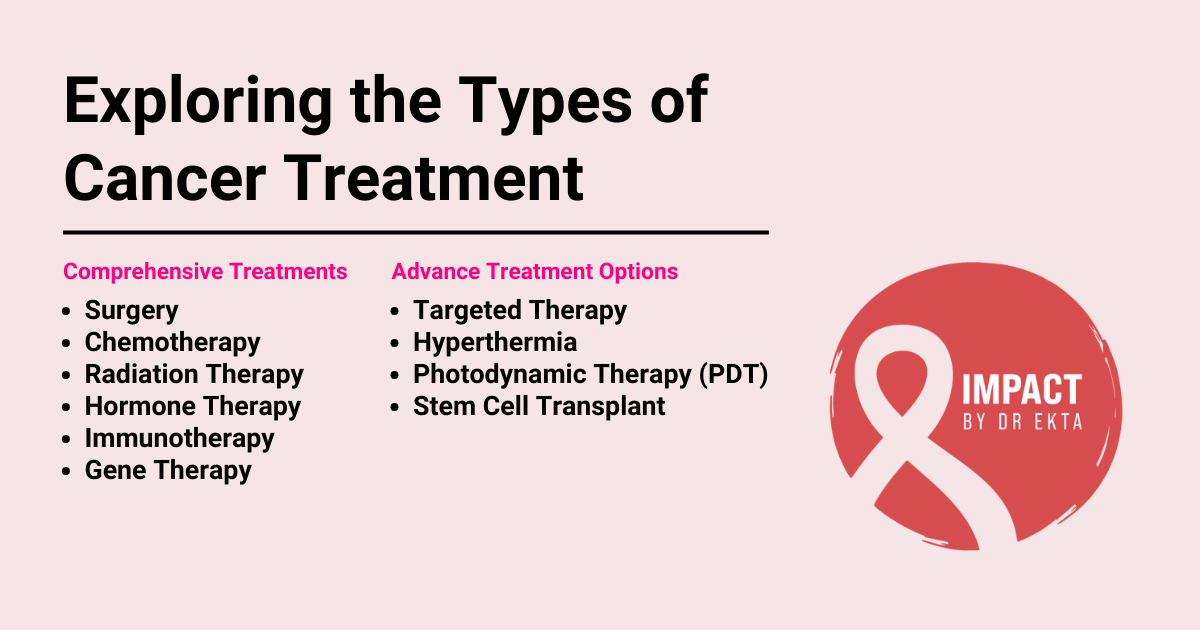Exploring the Types of Cancer Treatment
Namaste, I’m Dr. Ekta Vala Chandarana. Navigating through cancer treatment options can be a challenging journey. Understanding the different types of treatments available is crucial for patients and their families. The choice of treatment depends on several factors, including the type of cancer, its stage, location, size, and the patient’s overall health.
List of Types of Cancer Treatments

Cancer Surgery
Often the first line of attack against cancer, surgery aims to remove as much of the cancerous tissue as possible. Surgeons work to eliminate tumors and, in some cases, surrounding lymph nodes or tissues where the cancer might spread. Surgery varies widely depending on cancer’s location and stage, and it’s sometimes combined with other treatments for maximum effectiveness.
Chemotherapy
This treatment uses powerful drugs to target and kill rapidly dividing cancer cells. Chemotherapy can treat cancer throughout the body and is often used in conjunction with surgery or radiation to shrink tumors before removal or to target remaining cancer cells post-surgery.
Radiation Therapy
Radiation involves high-energy particles or waves to destroy or damage cancer cells. It’s a localized treatment, targeting specific areas of the body where cancer is present. Radiation therapy can be external, using a machine to direct radiation towards the cancer, or internal, where radioactive sources are placed inside the body near cancer cells.
Hormone Therapy
Essential for cancers that grow in response to hormones, such as certain breast and prostate cancers. Hormone therapy works by blocking the body’s natural hormones to cancer cells or by lowering the levels of hormones that fuel cancer growth.
Immunotherapy
A revolutionary approach that boosts the immune system’s ability to fight cancer. Immunotherapy treatments can help the body identify and attack cancer cells more effectively and are used for various cancer types.
Gene Therapy
A cutting-edge treatment that involves modifying the genes inside cancer cells or introducing new genes to help fight the disease. Though still largely experimental, gene therapy holds promise for targeting specific genetic changes found in cancer cells.
Advanced Treatment Options:
Delving deeper into cancer care, advanced treatment options harness cutting-edge science and technology to target cancer more precisely. Some of this are mention and defined below.
Targeted Therapy
Targets specific genes, proteins, or the tissue environment that contributes to cancer growth and survival. This type of therapy can block the growth and spread of cancer cells while limiting damage to healthy cells.
Hyperthermia
Uses heat to damage and kill cancer cells with minimal harm to normal tissue. Hyperthermia can be applied locally to small areas or throughout the body for more advanced cancers.
Photodynamic Therapy (PDT)
Combines a photosensitizing agent with light to kill cancer cells. PDT is primarily used for superficial cancers and is being explored for treating internal cancers.
Stem Cell Transplant
Replaces damaged bone marrow with healthy stem cells. It’s often used for cancers affecting the blood and bone marrow, like leukemia and lymphoma.
Making Informed Decisions
Choosing the right cancer treatment is a complex process that involves close collaboration between patients and their healthcare teams. Understanding the options, potential side effects, and the goals of each treatment can empower patients to make informed decisions about their care.
The Future of Cancer Treatment
The landscape of cancer treatment is evolving rapidly, with ongoing research and clinical trials exploring new ways to treat and manage cancer. By staying informed about the latest advancements and treatment strategies, patients can access the most effective care possible.
Conclusion
Cancer treatment is multifaceted, involving various strategies tailored to individual needs and specific types of cancer. From traditional approaches like surgery, chemotherapy, and radiation, to newer modalities like immunotherapy and targeted therapy, the goal remains the same: to eliminate cancer, minimize side effects, and improve quality of life. As we continue to advance our understanding of cancer and its treatment, the hope for more effective and less invasive treatments grows, offering new hope to patients around the world.
